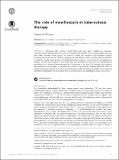Files in this item
The role of moxifloxacin in tuberculosis therapy
Item metadata
| dc.contributor.author | Gillespie, Stephen H | |
| dc.date.accessioned | 2016-03-10T16:30:05Z | |
| dc.date.available | 2016-03-10T16:30:05Z | |
| dc.date.issued | 2016-03 | |
| dc.identifier | 241406887 | |
| dc.identifier | 1979c348-6f8d-4bef-bad5-37d475a27602 | |
| dc.identifier | 26929417 | |
| dc.identifier | 85015457454 | |
| dc.identifier | 000383678600004 | |
| dc.identifier.citation | Gillespie , S H 2016 , ' The role of moxifloxacin in tuberculosis therapy ' , European Respiratory Review , vol. 25 , no. 139 , pp. 19-28 . https://doi.org/10.1183/16000617.0085-2015 | en |
| dc.identifier.issn | 0905-9180 | |
| dc.identifier.other | ORCID: /0000-0001-6537-7712/work/39477850 | |
| dc.identifier.uri | https://hdl.handle.net/10023/8397 | |
| dc.description | The author gratefully acknowledges the support of the TB Alliance and the European Developing Country Clinical trials Partnership (grant number: IP.2007.32011.011) for their financial support of trials by the author discussed in this work. Funding information for this article has been deposited with FundRef. | en |
| dc.description.abstract | Tuberculosis (TB) remains a global threat with more than 9 million new infections. Treatment remains difficult and there has been no change in the duration of the standard regimen since the early 1980s. Moreover, many patients are unable to tolerate this treatment and discontinue therapy, increasing the risk of resistance. There is a growing tide of multidrug resistance and few effective antibiotics to tackle the problem. Since the turn of the millennium there has been a surge in interest in developing new therapies for TB and a number of new drugs have been developed. In this review the repurposing of moxifloxacin, an 8-methoxy-fluoroquinolone, for TB treatment is discussed. The evidence that underpins the development of this agent is reviewed. The results of the recently completed phase III trials are summarised and the reasons for the unexpected outcome are explored. Finally, the design of new trials that incorporate moxifloxacin, and that address both susceptible disease and multidrug resistance, is described. | |
| dc.format.extent | 10 | |
| dc.format.extent | 324866 | |
| dc.language.iso | eng | |
| dc.relation.ispartof | European Respiratory Review | en |
| dc.subject | RA0421 Public health. Hygiene. Preventive Medicine | en |
| dc.subject | NDAS | en |
| dc.subject | SDG 3 - Good Health and Well-being | en |
| dc.subject.lcc | RA0421 | en |
| dc.title | The role of moxifloxacin in tuberculosis therapy | en |
| dc.type | Journal article | en |
| dc.contributor.institution | University of St Andrews. School of Medicine | en |
| dc.contributor.institution | University of St Andrews. Global Health Implementation Group | en |
| dc.contributor.institution | University of St Andrews. Gillespie Group | en |
| dc.contributor.institution | University of St Andrews. Biomedical Sciences Research Complex | en |
| dc.contributor.institution | University of St Andrews. Infection Group | en |
| dc.identifier.doi | 10.1183/16000617.0085-2015 | |
| dc.description.status | Peer reviewed | en |
This item appears in the following Collection(s)
Items in the St Andrews Research Repository are protected by copyright, with all rights reserved, unless otherwise indicated.

